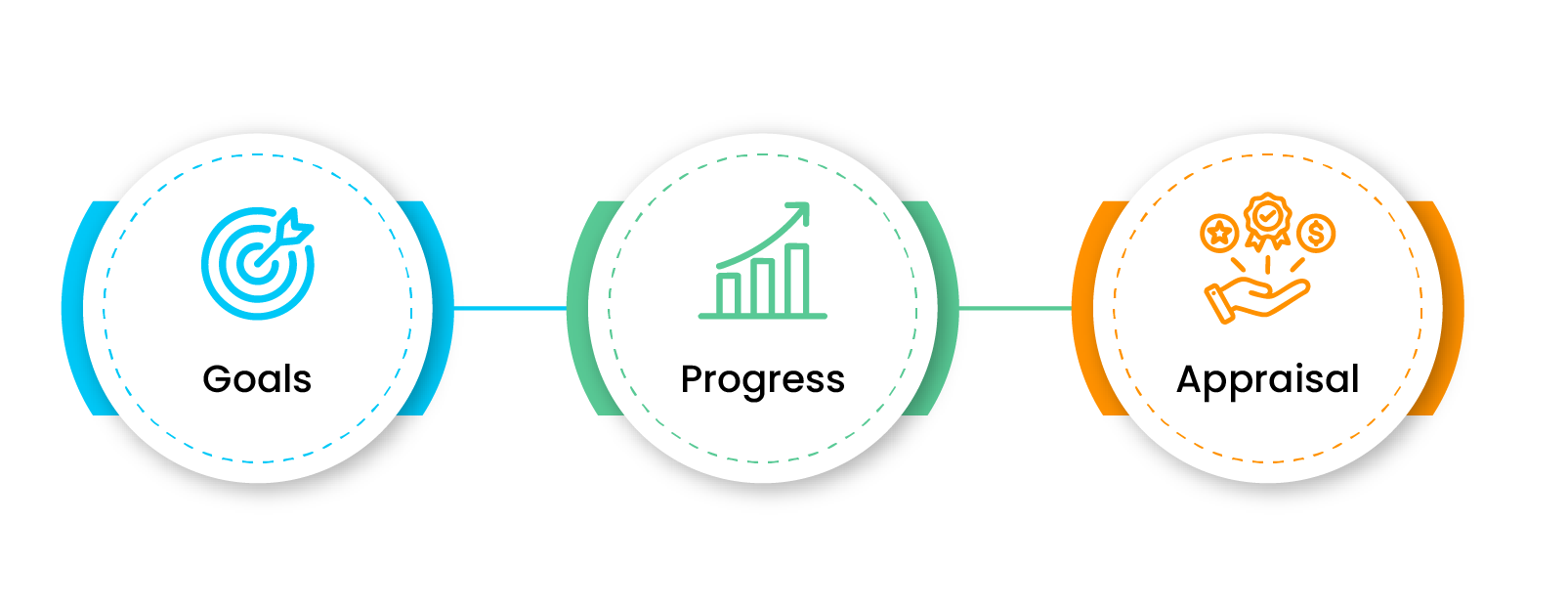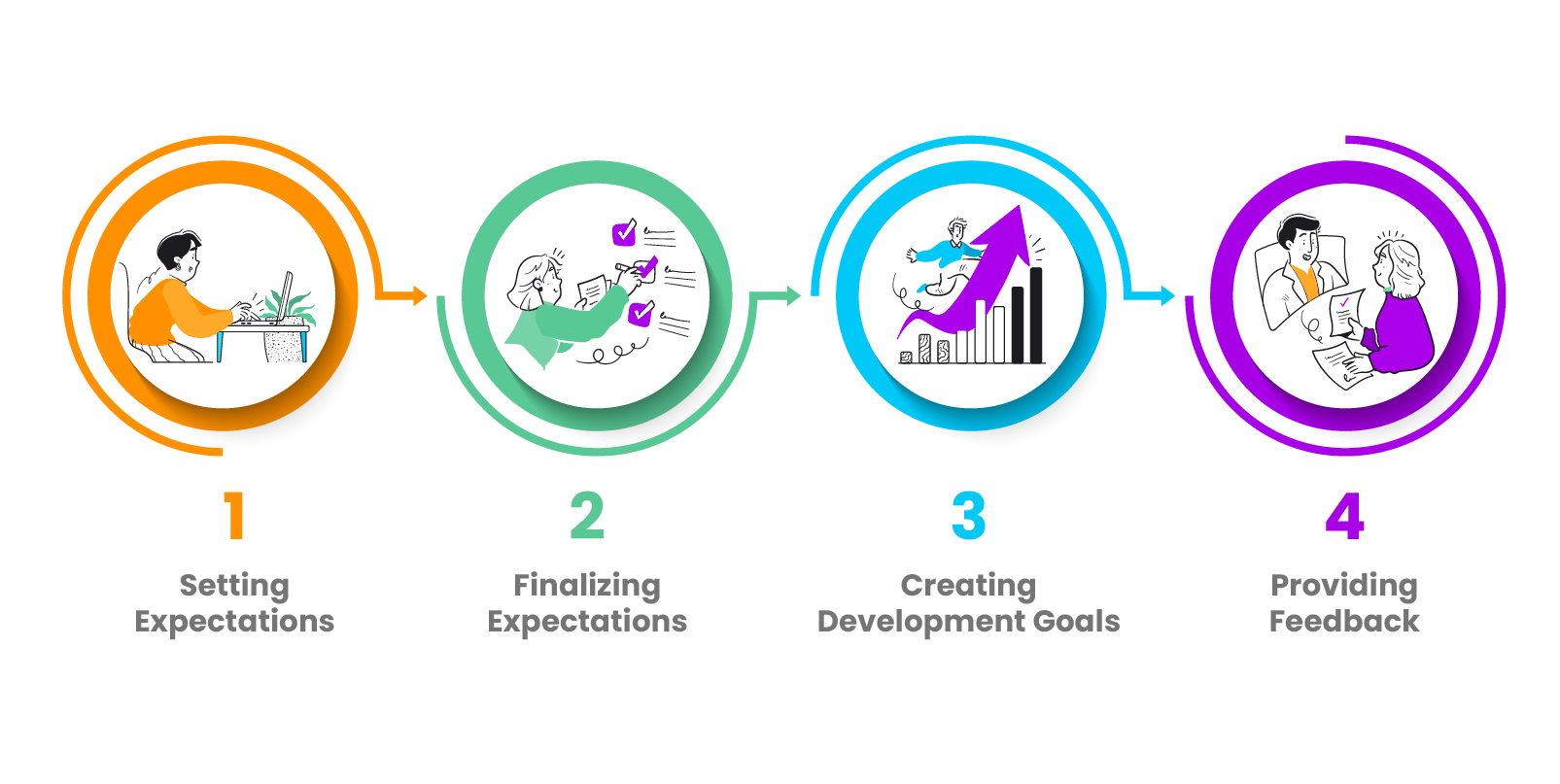Table of Contents
- 1. Introduction
- 2. Concept, Misconceptions, and Process
- 3. The Performance Management Process
- 4. Performance Management: Guiding Principles
- 5. Coaching ‒ An Effective Feedback Tool
- 6. Review: Guiding Principles
- 7. How to Distinguish Between ‘Doers’ and ‘Achievers’
- 8. Additional Methods for a Fully Rounded Performance Evaluation
- 9. Conclusion
Introduction
All businesses have something in common: their stakeholders aim to achieve common goals together. Goals are of three distinct types:
- Organizational goals: Business vision or mission will form the direction in which all stakeholders will follow
- Functional goals: Internal functions like Sales, Manufacturing, HR, Finance, etc., have to align with organizational goals and vision
- Individual goals: Individual employees have to align with both functional as well as organizational goals
Goals need to be specific, achievable, and time-bound. After the goals are set, a method has to be put in place to measure or evaluate the progress.
Organizational goals are measured through its balance sheet and functional goals are measured by Key Result Indicators (KRI). However, individual employee goals are measured by performance metrics.
This whole process is called Performance Management. While it takes time for planning and implementation, a streamlined performance management process can be a very effective motivator that helps organizations achieve success.
This guide covers individual employee performance management.
Concept, Misconceptions, and Process
Performance management is about managing goals, tracking progress, and appraising employees with data-backed insights.

Many organizations treat performance management as a mundane annual exercise with their employees. Also, most employees have the misconception that the annual performance exercise is all about money and promotions. Instead, their focus should be on getting to know how they progressed and contributed to the company’s growth.
Performance measurement has to be an ongoing process ‒ a process of communication between a manager and an employee. This occurs throughout the year in an honest effort to accomplish the strategic objectives of the function and specific time-bound targets. The communication process includes clarifying expectations, setting objectives, identifying goals, taking corrective measures, providing feedback, and reviewing results at regular intervals.
The Performance Management Process

1. Setting Performance Expectations
- Results are often measured through the use of objectives and standards.
- Actions and Behaviors can be measured through the use of performance dimensions.
- Focus on setting clear performance expectations (results + actions & behaviors) helps the employee know what needs to be done to be successful on the job.
- Through the use of objectives, standards, performance dimensions, and other measures, the process focuses on effort. This helps the department complete what needs to be done and provides a solid rationale for eliminating work that is no longer useful.
- Regular check-in discussions, which include status updates, coaching, and feedback, help promote flexibility, allowing you and the employee to identify problems early and change the course of a project or work assignment.
- Goals can be both short-term and long-term. Goals, by default, are based on individual scope of work and assignments but can include soft skill enhancements too
- Some organizations tend to focus on deliverables and project timelines so much that the goals become purely function-focused. At the end of the year, the discussions will be limited to productivity and not the recommended objective of a performance measurement. It should be an overall developmental exercise for the employee and can cover employees at any level of the organization.
Short-term goals are generally limited to a year. Example: apart from the daily scope of work, enhancement of functional/presentation skills, public speaking, etc. Long-term goals are where the end result and objectives would stretch over a longer period. For example, long-term projects or soft skill programs like team management, leadership skills development, or professional courses. HR and Managers must know the areas of evaluation in such scenarios.
Written, verifiable, and mutually understood performance expectations:
- Serve as an objective basis for communicating about performance
- Enable the employee to differentiate between acceptable and unacceptable results
- Increase job satisfaction since employees know when tasks are performed well
- Inform new employees of expectations about job performance
- Encourage an open and trusting relationship with employees
To perform well, employees need to know what is expected of them. The starting point is an up-to-date job description that describes the essential functions, tasks, and responsibilities of the job. It also outlines the general areas of knowledge and skills required of an employee to be successful in the job.
Performance expectations go beyond the job description. When you think about high-quality on-the-job performance, you are really thinking about a range of expected job outcomes.
- What goods and services should the job produce?
- What impact should the work have on the organization?
- How do you expect the employee to act with clients, colleagues, and supervisors?
- What are the organizational values the employee must demonstrate?
- What are the processes, methods, or means the employee is expected to use?
In discussing performance expectations, an employee should understand why the job exists, where it fits in the organization, and how the job’s responsibilities link to the organizational and departmental objectives. The range of performance expectations can be broad but can generally be broken into two categories:
- Results (The goods and services produced by an employee; often measured by objectives or standards)
- Actions & Behaviors (The methods and means used to make a product and behaviors and values demonstrated during the process. Actions and Behaviours can be measured through performance dimensions.)
Performance expectations serve as a foundation for communicating about performance throughout the year. They also serve as the basis for reviewing employee performance. When you and an employee set clear expectations about the results that must be achieved and the methods or approaches needed to achieve them, you establish a path to success.
2. Finalizing Performance Expectations

Put Expectations in Writing
A written summary of your discussions during the planning process serves as a record of your mutually understood expectations. Putting expected results (objectives and standards) and expected actions/behaviors (performance dimensions) in writing is useful when:
- Allocating resources,
- Discussing budgets, and
- Prioritizing programs.
Mutually developed written expectations also help focus on feedback and minimize ambiguity while assessing results.
Verify Expectations
Performance expectations should be verifiable. Early in the performance management cycle, you should take the employees’ input and identify how and where the evidence about the performance will be gathered.
Measurable (quantitative) expectations are the easiest ones to verify. Usually, the expectations cannot be put into measurable terms easily or accurately. At this point, consider developing qualitative expectations, which can generally be made verifiable by spelling out the criteria to be fulfilled, behaviors to be demonstrated, and/or target dates to be met.
Specifying how performance expectations will be verified at the time of assigning the responsibility helps employees keep track of their progress. It also makes check-in meetings and performance status updates much more focused and efficient.
There are many ways to verify performance; some of the most common ones are:
- Specific work products (tangible evidence that can be reviewed without the employee being present)
- Reports and records for attendance, safety, inventory, finance, etc.
- Checklists, completed by a client or supervisor, listing specific, observable criteria that need to be met for an expectation to be considered complete. Criteria usually require a “yes” or “no” answer to fields like “implement a new program by [x] date.”
- Direct observation
- Rating scales that define, as precisely as possible, behaviors at different levels of performance (behaviorally anchored rating scales)
- Commendations or constructive or critical comments about the employee’s work
3. Creating Development Goals
Managers and employees should work together to create development plans as part of the annual performance management process. The plan can focus on skills aimed at job mastery or combine job mastery with professional development skills.
- Job mastery skills are those that are necessary to successfully perform one’s job.
- Professional development skills are the skills and knowledge that go beyond the scope of the employee’s job description, although they may indirectly improve job performance.
Development plans commonly include classes but can also include elements such as cross-training and special project participation.
4. Providing Observation and Feedback
Once performance objectives and standards are established, you should observe an employee’s performance and check in regularly, providing feedback. You have a responsibility to recognize and reinforce strong performance by an employee and identify and encourage improvement where it is needed.
Some types of jobs and responsibilities have built-in feedback. In these jobs, the knowledge of the results comes from the work activity itself. Examples: when an electrician repairs a broken switch and it begins to work, when a development officer in charge of a capital campaign begins to receive donations, or when a professor successfully helps a student through a difficult process.
This kind of feedback is very effective because it is immediate. However, even jobs with immediate feedback can benefit from external feedback since it contributes to an employee’s overall knowledge of his/her results and work.
As a manager, you are most likely providing informal feedback almost every day. By observing and providing detailed, honest feedback, you play a critical role in the employee’s continued success and motivation to meet performance expectations.
Performance Management: Guiding Principles
Effective observation and feedback can:
- Strengthen communication between you and your employee
- Help the employee attain performance objectives and meet standards
- Increase employee motivation and commitment
- Maintain and increase the employee’s self-esteem
- Provide support
Coaching ‒ An Effective Feedback Tool
Coaching, a method of strengthening communication between you and your employee, can be used during check-in sessions. It helps shape performance and increases the likelihood that the employee’s results will meet your expectations. Coaching sessions provide you and the employee the opportunity to discuss progress toward meeting mutually established standards and objectives.

A coaching session focuses on one or two aspects of performance rather than the total review that takes place in a performance appraisal.
Review: Guiding Principles
Some goals of the performance review process are to help the employee:
- Feel positive about the job
- Feel appreciated for specific contributions
- Benefit from specific, constructive feedback
- Be informed about current and future performance objectives
- Stay motivated to do well and develop
- Be involved as a participant in the process
A key goal for you and your employee is to recognize the degree to which an employee was successful, or how well the person met expectations, be they objectives, standards, performance dimensions, or some other measure.
Preparing for the Review
Both you and your employee play an important role in creating a productive performance review process. Here are some suggestions to get the employee involved:
- Schedule a mutually convenient time and place for the performance review discussion. Allow enough time and ensure privacy.
- Explain that you would like the discussion to be a dialog, with input from both of you included in the final written document.
- Give the employee some options about how to prepare for the discussion. For example:
- Ask the employee to prepare a self-appraisal using the same form in your draft. The employee can address accomplishments and things that could be done better. Explain that you will be doing the same and that you may exchange these documents a few hours before your meeting
- Give the employee a list of questions to consider when evaluating his/her own performance. The questions could be:
- What have been your major accomplishments?
- What could you have done better?
- What could I do as your supervisor to help you do your job better?
- Would you like to see your responsibilities change? If so, how?
Prepare the review document, including as much information as possible:
- Job description
- Professional development over the review period
- Performancne standards and objectives
- Previous assessment
- Letters of commendation and/or criticism
- Input provided by key clients and colleagues
- Samples of work
- Records of disciplinary action
Consider this question: What can I do to help the employee do the job better and achieve developmental goals?
How to Distinguish Between ‘Doers’ and ‘Achievers’

Performance measurements generally end with providing the ratings to an employee. The commonly adopted ratings are:
Achieved – Employees who have just achieved their goals and objectives as expected; out of them, the inquisitive and good learners
Exceeded – Employees who have achieved their goals and objectives using smart tools, out-of-the-box thinking, enthusiasm/contagious energy, and motivation skills
Outstanding – Employees with all the above plus leadership qualities, who are self-motivated, potential future leaders in the organization, introduce or implement continuous process improvements, are trustworthy, reliable, dependable, etc.
Under Achieved – Employees who have not achieved their goals but have the potential to perform with constant supervision and micromanagement
Poor – Employees who neither fit the bill nor are motivated and lack the ability to learn should be exited
Not eligible – Employees who have just joined, are on probation, or on their way out
Additional Methods for a Fully Rounded Performance Evaluation
Whenever a Manager’s span of control exceeds a limit of direct reportees (the recommended number is 7 employees), there is a scope for missing out on an employee’s achievement due to the sheer volume of people one has to assess.
360-degree Appraisal
If a manager wants an independent assessment of an employee’s self-appraisal, the common method is a 360-degree appraisal. In this method, feedback on the performance is obtained from peers or co-workers, associates, and even vendors or clients.
The feedback provided by these touch points is important for a free evaluation of the employee’s behavior, coordination, or cooperation. For example, it is vital to obtain a positive client feedback on a sales or service engineer. If ignored, it could probably interrupt the success of the employee and future business with the client too.
Oftentimes, this method eliminates any aspects of bias towards an individual or even a group of people.
Team Assessment
The HR department in many medium- to large-scale companies tends to force-fit their employee ratings into a pattern for managing financial budgets or setting strict evaluation methods for employee performance. This approach makes Managers review individual performance microscopically and distinguish performance from non-performance. The most popular method is the ‘bell-curve’ method. It is an assessment activity that requires Managers to identify only a couple of team members to have ‘Exceeded’ ratings and only a couple of team members to have ‘Underachieved’ ratings. The rest of the team members will obviously fall in the ‘Achieved’ rating category. If we plot these numbers on an XY-Axis chart, they will form the shape of a bell.
Conclusion
Remember that each Manager is as good as his/her team. Moreover, the team’s or individual’s performance will reflect directly in a cascading manner upstream or downstream. Therefore, it is imperative to have a well-defined performance management process in the organization. Happy employees achieve better results, impacting the company’s overall success.
